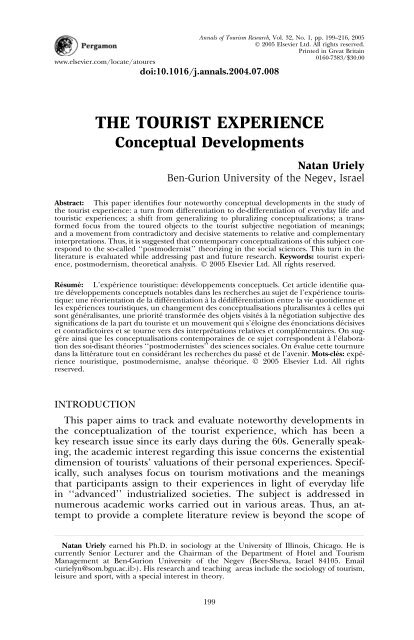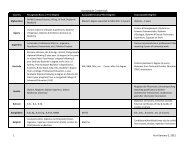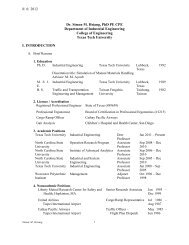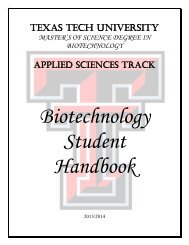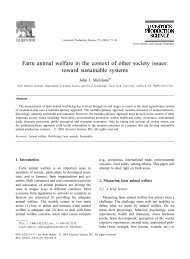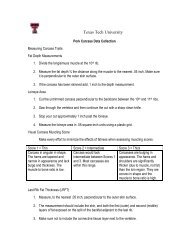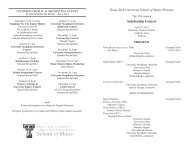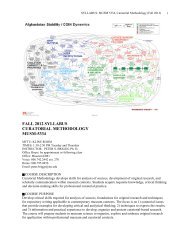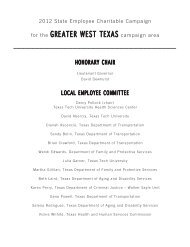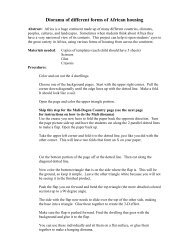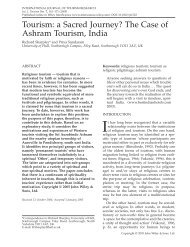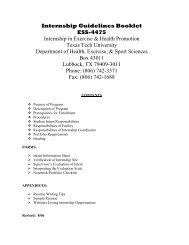Development of Tour Uriely 2005
Development of Tour Uriely 2005
Development of Tour Uriely 2005
Create successful ePaper yourself
Turn your PDF publications into a flip-book with our unique Google optimized e-Paper software.
www.elsevier.com/locate/atoures<br />
doi:10.1016/j.annals.2004.07.008<br />
Annals <strong>of</strong> <strong>Tour</strong>ism Research, Vol. 32, No. 1, pp. 199–216, <strong>2005</strong><br />
Ó <strong>2005</strong> Elsevier Ltd. All rights reserved.<br />
Printed in Great Britain<br />
0160-7383/$30.00<br />
THE TOURIST EXPERIENCE<br />
Conceptual <strong>Development</strong>s<br />
Natan <strong>Uriely</strong><br />
Ben-Gurion University <strong>of</strong> the Negev, Israel<br />
Abstract: This paper identifies four noteworthy conceptual developments in the study <strong>of</strong><br />
the tourist experience: a turn from differentiation to de-differentiation <strong>of</strong> everyday life and<br />
touristic experiences; a shift from generalizing to pluralizing conceptualizations; a transformed<br />
focus from the toured objects to the tourist subjective negotiation <strong>of</strong> meanings;<br />
and a movement from contradictory and decisive statements to relative and complementary<br />
interpretations. Thus, it is suggested that contemporary conceptualizations <strong>of</strong> this subject correspond<br />
to the so-called ‘‘postmodernist’’ theorizing in the social sciences. This turn in the<br />
literature is evaluated while addressing past and future research. Keywords: tourist experience,<br />
postmodernism, theoretical analysis. Ó <strong>2005</strong> Elsevier Ltd. All rights reserved.<br />
Résumé: L’expérience touristique: développements conceptuels. Cet article identifie quatre<br />
développements conceptuels notables dans les recherches au sujet de l’expérience touristique:<br />
une réorientation de la différentiation à la dédifférentiation entre la vie quotidienne et<br />
les expériences touristiques, un changement des conceptualisations pluralisantes à celles qui<br />
sont généralisantes, une priorité transformée des objets visités à la négotiation subjective des<br />
significations de la part du touriste et un mouvement qui s’éloigne des énonciations décisives<br />
et contradictoires et se tourne vers des interprétations relatives et complémentaires. On suggére<br />
ainsi que les conceptualisations contemporaines de ce sujet correspondent à l’élaboration<br />
des soi-disant théories ‘‘postmodernistes’’ des sciences sociales. On évalue cette tournure<br />
dans la littérature tout en considérant les recherches du passé et de l’avenir. Mots-clés: expérience<br />
touristique, postmodernisme, analyse théorique. Ó <strong>2005</strong> Elsevier Ltd. All rights<br />
reserved.<br />
INTRODUCTION<br />
This paper aims to track and evaluate noteworthy developments in<br />
the conceptualization <strong>of</strong> the tourist experience, which has been a<br />
key research issue since its early days during the 60s. Generally speaking,<br />
the academic interest regarding this issue concerns the existential<br />
dimension <strong>of</strong> tourists’ valuations <strong>of</strong> their personal experiences. Specifically,<br />
such analyses focus on tourism motivations and the meanings<br />
that participants assign to their experiences in light <strong>of</strong> everyday life<br />
in ‘‘advanced’’ industrialized societies. The subject is addressed in<br />
numerous academic works carried out in various areas. Thus, an attempt<br />
to provide a complete literature review is beyond the scope <strong>of</strong><br />
Natan <strong>Uriely</strong> earned his Ph.D. in sociology at the University <strong>of</strong> Illinois, Chicago. He is<br />
currently Senior Lecturer and the Chairman <strong>of</strong> the Department <strong>of</strong> Hotel and <strong>Tour</strong>ism<br />
Management at Ben-Gurion University <strong>of</strong> the Negev (Beer-Sheva, Israel 84105. Email<br />
). His research and teaching areas include the sociology <strong>of</strong> tourism,<br />
leisure and sport, with a special interest in theory.<br />
199
200 THE TOURIST EXPERIENCE<br />
this paper. Instead, the focus here is on identifying and evaluating<br />
major developments in the conceptualization <strong>of</strong> the experience. Specifically,<br />
by reviewing relevant literature across various topics, including<br />
the definition <strong>of</strong> the tourist role, typologies, authenticity, postmodern,<br />
and heritage tourism, four developments emerge: a reconsideration <strong>of</strong><br />
the distinctiveness <strong>of</strong> tourism from <strong>of</strong> everyday life experiences; a shift<br />
from homogenizing portrayals <strong>of</strong> the tourist as a general type to pluralizing<br />
depictions that capture the multiplicity <strong>of</strong> the experience; a<br />
shifted focus from the displayed objects provided by the industry to<br />
the subjective negotiation <strong>of</strong> meanings as a determinant <strong>of</strong> the experience;<br />
and a movement from contradictory and decisive academic discourse,<br />
which conceptualizes the experience in terms <strong>of</strong> absolute<br />
truths, toward relative and complementary interpretations.<br />
The current analysis suggests that these changes in conceptual<br />
trends involve a change in the style <strong>of</strong> academic theorizing. The conceptualizations<br />
derive from various theoretical frameworks, including<br />
phenomenology (Cohen 1979; <strong>Uriely</strong>, Yonai and Simchai 2002), a<br />
neo-Durkheimian perspective (MacCannell 1973), G<strong>of</strong>fmanian roletheory<br />
(Wickens 2002), conflict and cultural criticism (Barthes 1972;<br />
Boorstin 1964; Turner and Ash 1975), and a constructivist narrative-oriented<br />
approach (Elsrud 2004), but without attempting to endorse any<br />
<strong>of</strong> them. Instead, these are characterized and evaluated hereafter<br />
according to another theoretical construct, that <strong>of</strong> the distinction between<br />
‘‘modernist’’ and ‘‘postmodernist’’ forms or styles <strong>of</strong> academic<br />
knowledge (Bauman 1987, 1992; Denzin 1991; Flax 1990; Frazer<br />
1989; Hollinshead 2002; Ryan 2002; <strong>Uriely</strong> 1997). In line with this distinction,<br />
it is argued that while the early theories comply with the<br />
notion <strong>of</strong> modernist academic knowledge, contemporary conceptualizations<br />
<strong>of</strong> the same correspond to postmodernist modes <strong>of</strong> analysis.<br />
TOWARD POSTMODERNIST CONCEPTUALIZATIONS<br />
As a broad cultural phenomenon, postmodernity refers to a particular<br />
set <strong>of</strong> generalized developments that may constitute a new cultural paradigm<br />
and social consciousness (Lash and Urry 1987; Rojek 1995; Urry<br />
1990). However, postmodernity is also associated with diverse interrelated<br />
phenomena that developed after World War II in varied spheres<br />
<strong>of</strong> activity, such as art, architecture, sports, politics, cinema, tourism,<br />
and science (Denzin 1991). Accordingly, the term is utilized by scholars<br />
who grasp contemporary trends in tourism as manifestations <strong>of</strong> postmodernist<br />
rather than modernist culture (Baudrillard 1983; Eco 1986;<br />
Featherstone 1991; Fjellman 1992; Lash and Urry 1994; Munt 1994; Pretes<br />
1995; Rojek 1995; Urry 1990). Similarly, the notion <strong>of</strong> ‘‘postmodernist<br />
academic knowledge’’ or ‘‘postmodernist modes <strong>of</strong> theorizing’’ is<br />
utilized by those who perceive recent developments in the social sciences<br />
as reflection <strong>of</strong> postmodernity (Bauman 1987, 1992; Denzin 1991; Flax<br />
1990; Frazer 1989; Hollinshead 2002; Ryan 2002; <strong>Uriely</strong> 1997).<br />
Postmodernist forms and modes <strong>of</strong> theorizing are associated with a<br />
variety <strong>of</strong> characteristics, including deconstruction, subjectivity, skepti-
NATAN URIELY 201<br />
cism, anti-empiricism, intertextuality, and relativity (Bauman 1987,<br />
1992; Denzin 1991; Flax 1990; Frazer 1989; Hollinshead 2002; Ryan<br />
2002; <strong>Uriely</strong> 1997). The tendency to deconstruct modernist-like grand<br />
theories is grasped as part <strong>of</strong> its skepticism and reaction against the notion<br />
<strong>of</strong> a grand design <strong>of</strong> the social system. Thus, unlike grand theories<br />
that conceptualize societies as totalities, postmodern theorizing<br />
emphasizes diversity and richness <strong>of</strong> life (Denzin 1991; Frazer 1989;<br />
Ryan 2002). The inclination <strong>of</strong> the latter to stress the role <strong>of</strong> individuals<br />
to subjectively negotiate the meanings <strong>of</strong> their practices is related to its<br />
notion <strong>of</strong> power. In this respect, power is positively perceived as a constitutive<br />
activity rather than negative by (Frazer 1989). The compromising<br />
nature <strong>of</strong> postmodernist discourse and its tendency to<br />
conceptualize reality in terms <strong>of</strong> relative truths reflects its logic as nondualistic<br />
and anti-hierarchal (Lather 1991). In this regard, Denzin suggests<br />
that postmodern theories are characterized by a compromising<br />
nature that supports ‘‘both-and’’ rather than ‘‘either-or’’ statements<br />
(1991; 27, 151). Similarly, Bauman (1987) suggests that postmodernist<br />
modes <strong>of</strong> analysis are less authoritative, less conclusive, and more pluralized<br />
than modernist systems <strong>of</strong> knowledge. Accordingly, he refers to<br />
postmodernist theorists as interpreters, whereas modernist thinkers are<br />
referred to as legislators.<br />
The attempt made above to clarify the distinction between modernist<br />
and postmodernist theorizing would be incomplete without addressing<br />
the controversy surrounding it in the social sciences. To begin with,<br />
critics <strong>of</strong> the latter address the inconsistent and, in some cases, contradictory<br />
usage <strong>of</strong> the term postmodernism (Giddens 1987; Harvey<br />
1989). In this context, the problematic utilization <strong>of</strong> this term is recognized<br />
even by scholars who promote it. For instance, Bauman suggests<br />
that ‘‘postmodernity means very different things to many different people’’<br />
(1992:vii). Dissidents associate this ambiguity with over-free writing<br />
in which ‘‘anything goes’’ (Antonio 1991; Hollinshead 2002).<br />
Another point <strong>of</strong> criticism concerns the general idea that modernity<br />
has already been replaced by postmodernity. This proposition is challenged<br />
by Giddens (1990) who perceives both as two different forms<br />
Wang (2000:16) refers to the distinction as an analytical device used<br />
to characterize different phenomena <strong>of</strong> the same social order, thus prefering<br />
‘‘late modernity’’ over postmodernity.<br />
An objection to the distinction between modernist and postmodernist<br />
theories is provided by Curry (1991) who suggests that this distinction<br />
reflects an attempt <strong>of</strong> scholars to distinguish their work as<br />
postmodernist, rather than on a fundamental turn from earlier theories.<br />
In this context, he argues that postmodernist thinkers possess similar<br />
limitations to those they associate with the so-called ‘‘modernist<br />
form <strong>of</strong> knowledge’’. For example, postmodernist thinkers, such as<br />
Lyotard and Rorty, are criticized for both being selective in their works<br />
and for ignoring the intellectual complexity and the depth <strong>of</strong> earlier<br />
theories (Curry 1991; Ross 1988). Thus, the attack <strong>of</strong> postmodernist<br />
thinkers against the generalized and universalistic narratives <strong>of</strong> earlier<br />
theories is directed back against their own work. A related challenge<br />
to the distinction between modernist and postmodernist thought
202 THE TOURIST EXPERIENCE<br />
concerns the supposedly innovative nature <strong>of</strong> the latter. In this regard,<br />
Ryan (2002) notes that various aspects associated with postmodernist<br />
thought, such as the emphasis given to the context, the stress <strong>of</strong> plural<br />
reality, and the inclination for relativity were already seminal aspects<br />
<strong>of</strong> the phenomenological perspective.<br />
Other voices opposed to postmodernist views derive from neo-Marxist<br />
and power-conflict perspectives with regard to the little attention<br />
that the former give to power relations in general and to economic<br />
and class relations in particular (Callinicos 1990; Hollinshead 2002;<br />
Kaplan 1988; Morgan 1995). A related point <strong>of</strong> criticism addresses postmodernist<br />
thought as a destructive perspective, which fails to elaborate<br />
and transform new directions for political action or social reformation<br />
(Best 1994). The inclination to remain solely negative is also criticized<br />
with regard to the future <strong>of</strong> social sciences. In this context, it is argued<br />
the attack <strong>of</strong> postmodernist thought on the basic assumptions <strong>of</strong> social<br />
theory—including the quest for generalizations, unity <strong>of</strong> vision, and<br />
continuity <strong>of</strong> knowledge—is not followed by sufficient alternatives for<br />
structuring knowledge (Antonio 1991; Gitlin 1989).<br />
This controversy in the social sciences requires an additional clarification<br />
regarding the usage <strong>of</strong> the distinction between modernist and<br />
postmodernist theorizing in the current analysis. In this respect, the<br />
premise <strong>of</strong> this paper is that it is not necessary to agree with the postmodernist<br />
perspective in order to use this distinction as an analytical<br />
device. Similar to the position presented by Giddens (1990) and Wang<br />
(2000), one might be aware <strong>of</strong> a collection <strong>of</strong> similar developments<br />
that occur in various domains, including tourism or the social sciences,<br />
but still disagree with the view that these developments involve<br />
such an acute change that they justify the claim that postmodernity<br />
has already replaced modernity. Accordingly, the distinction between<br />
the two schools <strong>of</strong> thought applied in this paper does not reflect a<br />
position that the latter has already replaced the former. It does, however,<br />
assume that the depicted developments in the study <strong>of</strong> tourist<br />
experiences are associated with a wider cultural development, which<br />
is referred to in the literature as postmodernity. In addition, one<br />
might agree with the notion <strong>of</strong> so-called ‘‘postmodernist culture’’ in<br />
general, and ‘‘postmodernist forms <strong>of</strong> theorizing’’ in particular, and<br />
still criticize these contemporary developments. Thus, it is possible<br />
to utilize the distinction as an analytical device through which conceptual<br />
developments <strong>of</strong> the tourist experience are characterized and<br />
then challenged. In this context, by characterizing various conceptualizations,<br />
the current analysis includes dichotomies based on generalizations.<br />
Conceptualizations <strong>of</strong> the <strong>Tour</strong>ist Experience<br />
<strong>Development</strong>s discussed here exemplify the incorporation <strong>of</strong> postmodernist<br />
modes <strong>of</strong> analysis in recent conceptualizations <strong>of</strong> the tourist<br />
experience. Specifically, practices <strong>of</strong> deconstruction are illustrated in<br />
the first two developments, which focus on the tendency <strong>of</strong> recent
NATAN URIELY 203<br />
works to de-differentiate the experience from everyday life and to stress<br />
its pluralized nature, respectively. The third involves the growing attention<br />
that is given to the role <strong>of</strong> subjectivity in the constitution <strong>of</strong> the<br />
tourist experience. The fourth concerns the shift toward a compromising<br />
academic discourse, in which the tourist experience is conceptualized<br />
in terms <strong>of</strong> relative rather than absolute truths.<br />
De-differentiating the Experience. Early conceptualizations <strong>of</strong> the tourist<br />
experience emphasize its distinctiveness from everyday life. For example,<br />
Cohen (1972, 1979) refers to the quest for strangeness and novelty<br />
as a key element and argues that. . . ‘‘tourism is essentially a temporary<br />
reversal <strong>of</strong> everyday activities-it is a no-work, no-care, no-thrift situation’’<br />
(1979:181). Similarly, Smith defines the tourist as. . . ‘‘a temporarily<br />
leisured person who visits a place away from home for the<br />
purpose <strong>of</strong> experiencing change’’ (1978:1). The notion <strong>of</strong> this experience<br />
as contrary to the routine <strong>of</strong> everyday-life is also stressed in<br />
MacCannell’s portrayal <strong>of</strong> tourism as a modern form <strong>of</strong> the essentially<br />
religious quest for authenticity. In this regard, MacCannell argues that<br />
while modern individuals perceive their everyday life as inauthentic,<br />
‘‘authentic experiences are believed to be available only to those moderns<br />
who try to break the bonds <strong>of</strong> their everyday experiences and begin<br />
to live’’ (1973:159). The differentiation between everyday life and<br />
tourist experience was also highlighted by Turner and Ash (1975) who<br />
suggested that the temporary distance <strong>of</strong> tourists from their regular<br />
environments allows them to suspend the power <strong>of</strong> norms and values<br />
that govern their daily lives and to think about their own lives and societies<br />
from a different perspective.<br />
The notion <strong>of</strong> the tourist experience as disparate from the routine<br />
<strong>of</strong> everyday life has been challenged since the 90s by scholars who<br />
introduced the perspective <strong>of</strong> postmodern tourism (Lash and Urry<br />
1994; Munt 1994; Urry 1990). The premise suggests that while the<br />
modern era is characterized by processes <strong>of</strong> differentiation among<br />
normative, aesthetic, and institutional spheres <strong>of</strong> social activity, the<br />
postmodern condition involves processes <strong>of</strong> de-differentiation that<br />
blur these distinctions. In this context, Lash and Urry (1994) conceptualize<br />
the decreasing distinctions between everyday life and tourist<br />
experiences as ‘‘the end <strong>of</strong> tourism’’. Specifically, they argue that<br />
experiences that were once confined to tourism—including the enjoyment<br />
<strong>of</strong> gazing at distant sights and the pleasure <strong>of</strong> engaging in aspects<br />
<strong>of</strong> other cultures—are currently accessible in various contexts<br />
<strong>of</strong> everyday life. In the era <strong>of</strong> mass media, for instance, attractions<br />
can be enjoyed via video and virtual reality displays within the comforts<br />
<strong>of</strong> one’s home. Similarly, the proliferation <strong>of</strong> simulated environments<br />
might bring together multiple sites and sights from around the world<br />
in one’s nearby theme park or shopping mall. Accordingly, many tourist-related<br />
experiences are currently reachable without the necessity<br />
for travel to separate destinations. Consequently, Lash and Urry<br />
(1994) indicated a process through which people become tourists<br />
most <strong>of</strong> the time, whether they are taking a vacation or conducting<br />
daily activities.
204 THE TOURIST EXPERIENCE<br />
A similar process <strong>of</strong> de-differentiation between tourism and the routine<br />
<strong>of</strong> everyday life is delineated by Munt who argues that ‘‘tourism is<br />
everything and everything is tourism’’ (1994:104). Specifically, he mentions<br />
the growing tendency to combine a variety <strong>of</strong> activities, such as<br />
adventure trekking, climbing, skiing, and mountain biking with tourism.<br />
More significantly, he stresses penetrations, such as the proliferation<br />
<strong>of</strong> ecological, archeological, anthropological, and scientific types<br />
<strong>of</strong> tourism. In addition to the ‘‘intellectualization’’ he points out a<br />
process <strong>of</strong> ‘‘pr<strong>of</strong>essionalization’’ in the consumption <strong>of</strong> tourism. In this<br />
context, Munt suggests that the separation <strong>of</strong> occupational pr<strong>of</strong>essionalism<br />
and the consumption <strong>of</strong> tourism are beginning to blur. With respect<br />
to the penetration by occupational features, Munt mentions the<br />
development <strong>of</strong> tourism codes <strong>of</strong> ethics by travel-related and environmental<br />
organizations, such as <strong>Tour</strong>ism Concern and Green Flag International.<br />
At the same time, he describes the growth <strong>of</strong> outdoor training<br />
programs designed for managers as an example <strong>of</strong> the incorporation <strong>of</strong><br />
tourism practices in the work and pr<strong>of</strong>essional domain.<br />
The notion <strong>of</strong> tourism/leisure and work as contradicting experiences<br />
is also challenged by Ryan (2002) who points toward the invasion<br />
<strong>of</strong> leisure and recreation-related aspects into the workplace <strong>of</strong> s<strong>of</strong>twarebased<br />
industries, including gymnasia, spas, showers, and skateboard<br />
spaces. In another study, Ryan and Birks (2000) address the inclination<br />
<strong>of</strong> business tourists to combine tourism pursuits, such as seeing friends<br />
and relatives, attending sport events, or taking a holiday, during their<br />
work-related trips. Similarly, the interaction between work and tourism<br />
is extensively introduced in recent studies that focus on situations in<br />
which work-related and tourist-oriented activities are combined<br />
(Pizam, <strong>Uriely</strong> and Reichel 2000; <strong>Uriely</strong> 2001; <strong>Uriely</strong> and Reichel<br />
2000). In this context, a typology <strong>of</strong> tourists who combine work and<br />
tourist pursuits during their excursion is developed (<strong>Uriely</strong> 2001).<br />
Based on the meanings that these tourists assign to their experiences,<br />
four categories are depicted on a continuum from the most work-oriented<br />
to the most tourist-oriented: ‘‘touring pr<strong>of</strong>essional workers’’,<br />
who are mainly oriented toward work-related purposes and engage in<br />
tourist-oriented activities only as a by-product <strong>of</strong> their excursion; ‘‘migrant<br />
tourism workers’’, who travel in order ‘‘to make a living’’ and<br />
‘‘have fun’’ at the same time; ‘‘noninstitutionalized working-tourists’’,<br />
who engage in work while traveling in order to finance a prolonged<br />
trip; and, ‘‘working-holiday tourists’’, who perceive their work engagement<br />
as recreational that is part <strong>of</strong> their tourist activities. In line with<br />
these orientations, members <strong>of</strong> the two former types <strong>of</strong> tourists are referred<br />
to as ‘‘travelling workers,’’ and members <strong>of</strong> the two latter ‘‘working<br />
tourists’’ (<strong>Uriely</strong> 2001).<br />
Pluralizing the Experience. As part <strong>of</strong> an attempt to capture the essence<br />
<strong>of</strong> tourism, early conceptualizations were not concerned with the variety<br />
<strong>of</strong> meanings and motivations. Thus, while different seminal theorists,<br />
such as Boorstin (1964), MacCannell (1973), and Turner<br />
(1973), proposed different conceptualizations regarding the nature<br />
<strong>of</strong> the tourist experience in modern society, all <strong>of</strong> them presented<br />
homogenizing portrayals <strong>of</strong> it as a general type. This scholarly inclina-
NATAN URIELY 205<br />
tion was challenged by Cohen who proposed that ‘‘different kinds <strong>of</strong><br />
people may desire different modes <strong>of</strong> tourist experiences’’<br />
(1979:180). In line with this premise, Cohen developed a typology <strong>of</strong><br />
five modes <strong>of</strong> tourist experiences that span between the quest for mere<br />
pleasure on one end and the search for meanings on the other. His notion<br />
<strong>of</strong> plurality is also the premise <strong>of</strong> other categorizations, aiming to<br />
capture the existing variety in the practice <strong>of</strong> tourism (Cohen 1972;<br />
Krippendorf 1984; Pearce 1982; Plog 1977; Smith 1978).<br />
The emergence <strong>of</strong> typologies marks one step in the shift from essentialist<br />
and unifying depictions <strong>of</strong> the tourist experience as a general<br />
type toward an approach that stresses its diverse and plural characteristics.<br />
Another step in this direction is carried out in recent studies,<br />
which deconstruct well-established typologies by stressing the diversity<br />
within each <strong>of</strong> the existing categories in these typologies. This trend<br />
could be exemplified with regard to the four-fold tourist typology (drifter,<br />
explorer, individual mass, and organized mass) which construct<br />
the differentiation between noninstitutionalized and institutionalized<br />
tourists, respectively (Cohen 1972). With respect to the latter, the existing<br />
variety <strong>of</strong> experiences within the category <strong>of</strong> individual mass tourist<br />
is revealed in a recent study <strong>of</strong> British holidaymakers in Chalkidiki, in<br />
the region <strong>of</strong> Northern Greece (Wickens 2002). The study indicates<br />
that these holidaymakers are akin to the individual mass tourist type,<br />
but they are characterized by highly diversified patterns <strong>of</strong> interests<br />
and activities. Accordingly, they are further classified into five subtypes<br />
in accordance with dominant motivations: placing a strong emphasis<br />
on the local culture, searching for sensual and hedonistic pleasures,<br />
wishing for a romantic experience, questing for sunshine and hot climate,<br />
and enjoying the familiarity provided in a destination to which<br />
they return on an annual basis (Wickens 2002). Consequently, Wickens<br />
suggests that ‘‘...future studies should focus on multiple types <strong>of</strong> tourism,<br />
by identifying and examining the different micro-types, which are<br />
specific to the study’s particular situation’’ (2002:849).<br />
While Wickens’ study points toward the existing diversity among<br />
institutionalized tourists, a recent study <strong>of</strong> Israeli backpackers in various<br />
destinations stresses the multiplicity <strong>of</strong> experiences among noninstitutionalized<br />
tourists (<strong>Uriely</strong> et al 2002). Specifically, this study reveals<br />
that while most <strong>of</strong> the backpackers conform to the conventional forms<br />
(length <strong>of</strong> trip, means <strong>of</strong> transportation, category <strong>of</strong> accommodation,<br />
flexibility <strong>of</strong> the itinerary, etc.), they comply with the different modes<br />
<strong>of</strong> tourist experiences suggested by Cohen (1979). While some were<br />
mostly interested in mere pleasure-related activities and thus corresponded<br />
to the ‘‘recreational’’ or ‘‘diversionary’’ modes, others pursue<br />
pr<strong>of</strong>ound meanings and conform to the ‘‘experiental’’, ‘‘experimental’’,<br />
or ‘‘existential’’ modes (<strong>Uriely</strong> et al 2002). Based on these findings,<br />
the study places doubt on the implicit inclination to couple<br />
together external practices and internal meanings and to assume that<br />
tourists who travel in a similar form share the same experiences. Moreover,<br />
the study <strong>of</strong> these backpackers illustrates another dimension in<br />
the growing notion <strong>of</strong> the tourist experience as a diverse and a plural<br />
phenomenon. Specifically, while this study shows that different people
206 THE TOURIST EXPERIENCE<br />
may engage in different experiences, it also points toward the existence<br />
<strong>of</strong> multi-type individual backpackers who correspond to more than one<br />
mode <strong>of</strong> experience across their backpacking biography or even during<br />
a single trip (<strong>Uriely</strong> et al 2002). In this regard, this backpacker is<br />
akin to Feifer’s (1985) earlier conceptualization <strong>of</strong> the ‘‘post tourist’’,<br />
who enjoys the movement across different types <strong>of</strong> experiences in a<br />
single excursion.<br />
The Role <strong>of</strong> Subjectivity. The current notion <strong>of</strong> the tourist experience as<br />
a diverse phenomenon is accompanied by another development in<br />
which attention is shifted from the displayed objects provided by the<br />
industry to the tourist subjective negotiation <strong>of</strong> meanings as a determinant<br />
<strong>of</strong> the experience. This shift is evident in various studies, including<br />
the conceptualization <strong>of</strong> authenticity, the emerging research area<br />
<strong>of</strong> heritage tourism, as well as the typologies described above. With respect<br />
to the latter, the further classification <strong>of</strong> institutionalized tourist<br />
conducted by Wickens (2002) serves her attempt to stress the subjective<br />
ability <strong>of</strong> these holidaymakers to assign different meanings to their<br />
experiences. Specifically, by drawing upon G<strong>of</strong>fman’s (1961, 1967) role<br />
theory, Wickens (2002) shows that while holidaymakers are committed<br />
to the individual mass tourist role arranged for them by the industry<br />
(the provided object), they choose to step out <strong>of</strong> it and assign themselves<br />
to one <strong>of</strong> the subjective roles or micro-types, which shape their<br />
experiences. Similarly, <strong>Uriely</strong> et al (2002) showed that while the Israeli<br />
backpackers are committed to this form <strong>of</strong> tourism (which could be<br />
grasped as a given object <strong>of</strong> tourism), they subjectively construct their<br />
experiences in line with one or more <strong>of</strong> the modes suggested by Cohen<br />
(1979). These further classifications <strong>of</strong> well-established typologies challenge<br />
the position that the experience is solely shaped by the industry<br />
and carried out by passive consumers. Instead, these deconstructions <strong>of</strong><br />
existing typologies stress the importance <strong>of</strong> the individual’s practice, in<br />
which the subjective negotiation <strong>of</strong> meanings by the human actor is<br />
illuminated. Clearly, this position is also noticeable with regard to<br />
the multi-type backpacker (<strong>Uriely</strong> et al 2002) and the post-tourist<br />
(Feifer 1985) who subjectively construct their personal experience by<br />
taking fragments from different modes or products provided by the<br />
industry and reassemble them as they choose.<br />
The shift from the objects provided by the industry to the role tourist<br />
subjectivity in the construction <strong>of</strong> experiences is well exemplified with<br />
respect to the issue <strong>of</strong> authenticity. In this context, Wang (2000) identifies<br />
two object-related notions <strong>of</strong> authentic experiences that exist in<br />
the literature (objective and constructive authenticity) and introduces<br />
a new approach (existential authenticity), which emphasizes tourists’<br />
subjective activities. Objective authenticity is associated with the early<br />
theorists, such as Boorstin (1964) and MacCannell (1973), who share<br />
a similar notion <strong>of</strong> authenticity despite their debate regarding the fundamental<br />
quest <strong>of</strong> tourist in the modern era. Specifically, both Boorstin<br />
(1964) and MacCannell (1973) apply a museum-like usage <strong>of</strong> the term<br />
authenticity that stresses the originality <strong>of</strong> the toured object. In line<br />
with this approach, authentic experiences in tourism are equated to<br />
epistemological experiences <strong>of</strong> displayed objects which are found to
NATAN URIELY 207<br />
be genuine. Constructive authenticity is associated with those who challenge<br />
the simplistic notion <strong>of</strong> objective authenticity and argue for a<br />
more complex and constructive one (Bruner 1989; Cohen 1988;<br />
Hobsbawn and Ranger 1983; Salamone 1997; Silver 1993). According<br />
to this approach, displayed objects are considered to be authentic<br />
not because they are inherently so but because <strong>of</strong> their construction<br />
as such by tourists or service providers in terms <strong>of</strong> points <strong>of</strong> view, perspectives,<br />
or powers. Therefore, authentic experiences and the authenticity<br />
<strong>of</strong> displayed objects in tourism are considered to constitute one<br />
another. While the early approach <strong>of</strong> objective authenticity concerns<br />
the attributes <strong>of</strong> displayed object solely, the constructive perspective<br />
highlights the role <strong>of</strong> people in the construction <strong>of</strong> attributes associated<br />
with displayed objects. Yet, both perspectives share the position<br />
that authentic experiences derive from visiting attractions provided<br />
by the industry. Unlike both objective and constructive authenticities,<br />
Wang’s (2000) existential authenticity has nothing to do with that <strong>of</strong><br />
the displayed objects. Instead, it corresponds to a potential existential<br />
state <strong>of</strong> being, which is activated by the participant practices. According<br />
to this perspective, tourists may feel that they themselves are much<br />
more authentic when they engage in nonordinary activities, in which<br />
they are more freely self-expressed than in daily life.<br />
While the growing attention that is given to the subjectivity <strong>of</strong> tourist<br />
experiences is clearly evident in the contexts <strong>of</strong> typologies and the<br />
study <strong>of</strong> authenticity, a similar development seems to be instigated<br />
within the study <strong>of</strong> heritage tourism (Poria, Butler and Airey 2003)<br />
and urban tourism (Page 2002). In this context, Poria and colleagues<br />
have recently challenged the inclination <strong>of</strong> previous studies to focus solely<br />
on the supply <strong>of</strong> heritage attractions and its management (Crange<br />
1999; Halewood and Hannam 2001; Hewison 1987; Garrod and Fyall<br />
2000; Seale 1996). Instead, they suggest that individuals’ subjective perceptions<br />
and behaviors are the core elements <strong>of</strong> heritage tourism experiences<br />
and thus require emphasis. This point <strong>of</strong> view is also<br />
highlighted by Ashworth (1998) who suggests that different individuals<br />
perceive and encounter heritage spaces in different ways based on<br />
their cultural background. Moreover, similar to Wang’s notion <strong>of</strong> existential<br />
authenticity, Uzzell suggests that ‘‘museums and interpretive<br />
centers can be seen as places where people come to understand themselves’’<br />
(1998:16).<br />
Toward Relative Interpretations. The question whether the distinction<br />
made in the literature between modern and postmodern tourism reflects<br />
upon concrete developments in the nature <strong>of</strong> the tourist experience<br />
is a matter <strong>of</strong> intellectual debate. Yet, a comparison between the<br />
early theories <strong>of</strong> modern tourism and later conceptualizations <strong>of</strong> postmodern<br />
tourism reveals significant differences in terms <strong>of</strong> style and<br />
form <strong>of</strong> theorizing. Specifically, it is suggested that while the former<br />
conceptualize the tourist experience in terms <strong>of</strong> absolute truths, the<br />
latter make use <strong>of</strong> concepts <strong>of</strong> relative truths. Thus, unlike the debates<br />
between competing theories <strong>of</strong> modern tourism, the discourse between<br />
different approaches <strong>of</strong> postmodern tourism is characterized<br />
by compromising statements.
208 THE TOURIST EXPERIENCE<br />
In addition to their tendency to homogenize the experience as a<br />
general type, most <strong>of</strong> the early theorists were unified in their notion<br />
<strong>of</strong> tourism as a modern phenomenon. Nevertheless, studies were dominated<br />
by two competing standpoints in early days. One side <strong>of</strong> the debate<br />
took the form <strong>of</strong> social criticism, in which tourism was perceived as<br />
another example <strong>of</strong> cultural decadence in modern capitalist societies<br />
(Barthes 1972; Boorstin 1964; Turner and Ash 1975). According to this<br />
approach, the tourist experience was viewed as a superficial and trivial<br />
quest for ‘‘pseudo-events’’ and artificial attraction. The opposing conceptual<br />
approach was primarily presented by MacCannell (1973) who<br />
conceptualized the experience as a meaningful modern ritual which<br />
involves a quest for the authentic. The polemic between these two perspectives<br />
was manifested in MacCannell’s direct attack against Boorstin’s<br />
standpoint, to which he referred to as a snobbish attitude rather<br />
than an academic analysis that is based on empirical research (Mac-<br />
Cannell, 19731973:600). This attempt to de-legitimize the competing<br />
approach illustrates the noncompromising style <strong>of</strong> discourse <strong>of</strong> the<br />
early theories.<br />
A change in the style and form <strong>of</strong> theorizing has been noticeable<br />
since the late 70s and the early 80s, with the appearance <strong>of</strong> academic<br />
publications that associate contemporary tourism-related practices<br />
and experiences with postmodernist culture (Baudrillard 1983; Eco<br />
1986; Featherstone 1991; Lash and Urry 1994; Munt 1994; Pretes<br />
1995; Rojek 1995; Urry 1990). In this context, the term ‘‘postmodern<br />
tourism’’ was utilized with regard to a variety <strong>of</strong> developments, including<br />
the emergence <strong>of</strong> alternatives to the conventional mass tourism;<br />
the flourishing <strong>of</strong> nature-related and environment-oriented holidays;<br />
the growing attraction <strong>of</strong> nostalgia and heritage related sites; and the<br />
growing quest for simulated and theme-oriented tourism attractions.<br />
In spite <strong>of</strong> this inconsistency in the usage <strong>of</strong> the term ‘‘postmodern<br />
tourism’’, it is possible to point toward two main developments associated<br />
with the postmodern era: the ‘‘simulational’’ and the ‘‘other’’<br />
postmodern tourism (Munt 1994; <strong>Uriely</strong> 1997). The former is focused<br />
around ‘‘hyperreal’’ experience and refers to simulated themeparks<br />
and other contrived attractions as typical postmodern environments<br />
(Baudrillard 1983; Eco 1986; Featherstone 1991; Fjellman 1992; Gottdiener<br />
1995; Lash and Urry 1994; Pretes 1995; Urry 1990). Conceptualizations<br />
<strong>of</strong> the ‘‘other’’ postmodern tourism stress the search for the<br />
authentic and point to the growing appeal <strong>of</strong> the natural and the countryside<br />
as postmodern expressions (Barrett 1989; Munt 1994; Poon<br />
1989; Urry 1990).<br />
The distinction between the ‘‘simulational’’ and the ‘‘other’’ appears<br />
to follow the aforementioned polarity within the earlier theories.<br />
While the ‘‘simulational’’ development follows Boorstin’s notion <strong>of</strong><br />
‘‘pseudo-events’’ (1964), the trend toward the ‘‘other’’ is compatible<br />
with MacCannell’s argument regarding the quest for authenticity<br />
(1973). However, unlike the earlier notions <strong>of</strong> modern tourism, the<br />
two dimensions <strong>of</strong> postmodern tourism do not derive from two opposing<br />
camps <strong>of</strong> scholars. On the contrary, some <strong>of</strong> the important views<br />
include both the ‘‘simulational’’ and the ‘‘other’’ dimensions in their
NATAN URIELY 209<br />
complete portrayal <strong>of</strong> postmodern tourism (Urry 1990; <strong>Uriely</strong> 1997).<br />
Furthermore, unlike former theories <strong>of</strong> modern tourism, both dimensions<br />
generate complementary rather than contradictory perspectives.<br />
For instance, Munt’s position regarding the ‘‘simulational’’ developments<br />
is evident already in the first sentence <strong>of</strong> his work on the<br />
‘‘other’’ postmodern tourism: ‘‘I do not set out to challenge these<br />
but to consider figuratively the other possibilities <strong>of</strong> postmodern tourism’’<br />
(1994:101).<br />
CONCLUSION<br />
The objective <strong>of</strong> this paper was to track and analyze conceptual developments<br />
in the study <strong>of</strong> the tourist experience. In light <strong>of</strong> the ample academic<br />
works regarding this subject and mainly its spread across several<br />
subareas <strong>of</strong> tourism studies, an attempt to provide a complete literature<br />
review was precluded in this paper. Thus, without claiming to capture all<br />
<strong>of</strong> the developments in study <strong>of</strong> the tourist experience, this paper<br />
identified four significant trends in its conceptualization: from differentiation<br />
to re-differentiation <strong>of</strong> everyday life and tourism; from generalizing<br />
to pluralizing portrayals <strong>of</strong> the tourist experience; from focusing<br />
on the toured objects to the attention given to the role <strong>of</strong> subjectivity in<br />
the constitution <strong>of</strong> experiences; and from contradictory and decisive<br />
statements to relative and complementary interpretations.<br />
In light <strong>of</strong> the first three conceptual developments the tourist experience<br />
is currently depicted as an obscure and diverse phenomenon,<br />
which is mostly constituted by the individual consumer. This perspective<br />
regarding the nature <strong>of</strong> contemporary tourist experiences raises<br />
several important issues that need to be dealt with by planners, managers,<br />
and marketers. For example, the availability <strong>of</strong> various aspects<br />
<strong>of</strong> the tourist experience in the routine <strong>of</strong> everyday life seems to<br />
threaten future demands. In addition, the impact <strong>of</strong> practitioners in<br />
the industry needs to be reexamined in light <strong>of</strong> the supposedly<br />
increasing role <strong>of</strong> subjectivity. For instance, the possible constitution<br />
<strong>of</strong> various experiences within the established category <strong>of</strong> individual<br />
mass tourists (Wickens 2002) requires rethinking in terms <strong>of</strong> planning,<br />
managing, and marketing resorts that host this tourist segment.<br />
These, and other practical implications <strong>of</strong> recent conceptualizations,<br />
need to be considered as important issues. Nevertheless, the analysis<br />
carried out in this paper concerns mostly the consequences <strong>of</strong> the<br />
four conceptual developments rather than on the practice <strong>of</strong> tourism<br />
in real life.<br />
By reviewing the four trends as a whole, it is argued that while the<br />
early theories <strong>of</strong> the tourist experience complied with the so-called<br />
‘‘modernist’’ form <strong>of</strong> theorizing in the social sciences, contemporary<br />
conceptualizations <strong>of</strong> the same issue correspond to modes <strong>of</strong> analysis<br />
referred to in the literature as ‘‘postmodernist’’ thought. In this<br />
context, the association between postmodernist theorizing and practices<br />
<strong>of</strong> deconstruction (Denzin 1991; Frazer 1989; Ryan 2002) is illustrated<br />
in the first two developments, which emphasize processes <strong>of</strong>
210 THE TOURIST EXPERIENCE<br />
de-differentiation. Specifically, the tendency <strong>of</strong> recent studies to de-differentiate<br />
everyday life and tourist experiences deconstructs the early<br />
definitions which emphasize distinctiveness. Practices <strong>of</strong> deconstruction<br />
are also evident in the shift from generalizing toward pluralizing<br />
depictions <strong>of</strong> the tourist experience, which involves two stages. In the<br />
first, the early conceptualizations are deconstructed by the emergence<br />
<strong>of</strong> tourist typologies. The second is manifested in recent studies that<br />
deconstruct well-established typologies by stressing the diversity <strong>of</strong> tourist<br />
experiences within each <strong>of</strong> the existing categories in these<br />
typologies.<br />
The third development presented in this study indicates how the<br />
attention <strong>of</strong> researchers was shifted from the displayed objects to the<br />
tourist subjective negotiation <strong>of</strong> meanings. This clearly illustrates<br />
the inclination <strong>of</strong> postmodernist thought to stress the role <strong>of</strong> subjectivity<br />
(Frazer 1989; <strong>Uriely</strong> et al 2002). The fourth development indicated<br />
above—from debates that existed between competing standpoints <strong>of</strong><br />
modern tourism to the compromising nature <strong>of</strong> the discourse between<br />
different interpretations <strong>of</strong> postmodern tourism—corresponds to the<br />
nondualistic and anti-hierarchal intellectual attitude associated with<br />
postmodernist modes <strong>of</strong> analysis (Bauman 1987; Denzin 1991; Lather<br />
1991).<br />
By utilizing the modernist/postmodernist dichotomy, this analysis<br />
acknowledges that a general cultural change referred to in the literature<br />
as postmodernity is underway, and that it affects various domains<br />
<strong>of</strong> cultural activity, including the fashion <strong>of</strong> constructing knowledge in<br />
tourism studies. Specifically, the analysis presented above suggests that<br />
the depicted developments are not detached from a contemporary<br />
trend in the social sciences addressed as ‘‘postmodernist thinking’’,<br />
which is in itself a manifestation <strong>of</strong> a wider cultural change referred<br />
to as postmodernity. Nevertheless, the modernist/postmodernist<br />
dichotomy utilized in this analysis should not be grasped as a proposition<br />
regarding the extent <strong>of</strong> change or competition that contemporary<br />
conceptualizations introduce to the literature on the tourist experience.<br />
Instead, it is suggested that contemporary conceptualizations <strong>of</strong><br />
the tourist experience introduce complementary extensions to the earlier<br />
theories rather than a contrasting new approach that invalidates<br />
them. For instance, the essentialist views <strong>of</strong> Boorstin (1964) and<br />
MacCannell (1973) are included in Cohen’s phenomenological typology<br />
<strong>of</strong> tourist experiences (1979), which is intersected with the differentiation<br />
between institutionalized and noninstitutionalized tourists<br />
(Cohen 1972) in order to create the recent subtypology that captures<br />
the diversity among backpackers (<strong>Uriely</strong> et al 2002). In this process, later<br />
conceptualizations seem to introduce additions rather than a contrasting<br />
alternative to the logic <strong>of</strong> earlier works. In this respect, the<br />
current analysis challenges the notion <strong>of</strong> postmodernist thinking as a<br />
contesting and sharp departure from earlier modernist theorizing<br />
(Bauman 1987, 1992; Denzin 1991; Flax 1990; Frazer 1989). Thus, it<br />
is suggested that with regard to the specific trends in the literature<br />
the term late modernist (Giddens 1990; Wang 2000) seems to be more<br />
appropriate than postmodernist.
NATAN URIELY 211<br />
The evaluation <strong>of</strong> the shift toward postmodernist or late modernist<br />
theorizing in terms <strong>of</strong> its promises and threats to future research is required<br />
as well. In this regard, one might appreciate the practice <strong>of</strong><br />
deconstruction, including the de-differentiating and the pluralizing<br />
depictions <strong>of</strong> the tourist experience, for their rising sense <strong>of</strong> sensitivity<br />
to the complexity and the diversity <strong>of</strong> tourism. Indeed, early generalizations<br />
were not sensitive to issues such as gender-related or cultural<br />
diversity. With respect to the former, for instance, Elsrud (2004) argues<br />
against the lack <strong>of</strong> gender awareness in the literature although there is<br />
so far no evidence suggesting a similarity between the ways in which<br />
men and women interpret their tourist activities.<br />
Similarly, most <strong>of</strong> the generalizing conceptualizations concern the<br />
mind <strong>of</strong> the Western tourist, while ignoring other voices, whether<br />
Japanese, Singaporean, or Brazilian (Elsrud 2004; Wang 2000). Thus,<br />
pluralizing depictions <strong>of</strong> the tourist experience, which are sensitive to<br />
gender or cultural diversity, seems to be appropriate for future research.<br />
However, the inclination <strong>of</strong> earlier theories to generalize<br />
and differentiate the tourist experience from the routine <strong>of</strong> daily life<br />
is probably part <strong>of</strong> their attempt to capture the essence <strong>of</strong> the investigated<br />
phenomenon rather than their lack <strong>of</strong> awareness <strong>of</strong> its<br />
diversity. Such a modernist attempt to track the essence <strong>of</strong> a phenomenon<br />
by generalizing is particularities aims to make sense <strong>of</strong> its diversity<br />
rather than to deny it. By turning away from this fundamental<br />
attempt <strong>of</strong> scientific practice, the recent deconstructions appear to<br />
threaten the possibility <strong>of</strong> structuring future knowledge. In this respect,<br />
the recent conceptualizations comply with the notion <strong>of</strong> postmodernist<br />
thought as a destructive perspective, which fails to<br />
elaborate sufficient alternatives for structuring knowledge (Antonio<br />
1991; Gitlin 1989).<br />
Therefore, in addition to their deconstruction in recent studies,<br />
early conceptualizations <strong>of</strong> the tourist experience need to be reconstructed<br />
in future studies. Specifically, further studies are encouraged<br />
to redefine the current distinctions between tourist and everyday life<br />
experience and to develop new typologies, which capture the logic <strong>of</strong><br />
contemporary variations. For instance, if work and tourism are currently<br />
intertwined (Pizam et al 2000; <strong>Uriely</strong> 2001; <strong>Uriely</strong> and Reichel<br />
2000), future studies should specify which types <strong>of</strong> work-related activities<br />
are incorporated in contemporary tourist experiences. Questions<br />
regarding the remaining similarities within institutionalized holidaymakers<br />
or backpackers need also to be addressed in light <strong>of</strong> recent<br />
studies, which stress the multiplicity <strong>of</strong> experiences that are available<br />
within each <strong>of</strong> these conventional categories <strong>of</strong> tourism (<strong>Uriely</strong> et al<br />
2002; Wickens 2002).<br />
The postmodernist inclination toward subjectivity is another problematic<br />
aspect <strong>of</strong> recent conceptualizations. First, it is suggested that<br />
an approach that ignores the external opportunities or constraints imposed<br />
on the individual cannot provide a complete depiction <strong>of</strong> the<br />
tourist experience. Second, the focus on subjectivity could be seen as<br />
a naive perspective, which assumes that tourism is an area <strong>of</strong> life that<br />
facilitates a real freedom <strong>of</strong> choice. In contrast to this view, it is
212 THE TOURIST EXPERIENCE<br />
suggested that like all other social activities, tourism and leisure are<br />
also subjected to processes <strong>of</strong> class, ethnic, or gender related domination,<br />
which impose constraints on the degree <strong>of</strong> freedom associated<br />
with the tourist experience. Such a power-conflict perspective is applied<br />
by Hollinshead (2002) who criticizes postmodernist thought for<br />
ignoring the power <strong>of</strong> the industry to shape the interpretation <strong>of</strong> heritage<br />
sites in line with the historical view <strong>of</strong> specific interest groups.<br />
Third, ignoring the displayed objects provided by the industry assumes<br />
that differences in interpretations are related solely to the characteristics<br />
<strong>of</strong> the individual tourist. Nevertheless, it is also possible to assume<br />
that some objects or forms <strong>of</strong> tourism are open to a wider variety <strong>of</strong><br />
interpretation than others.<br />
Thus, future research should not ignore the nature <strong>of</strong> the specific<br />
visited object or the particular form <strong>of</strong> tourism as a determinant <strong>of</strong><br />
the subjective experience. For example, questions regarding whether<br />
independent excursions may be experienced in more various ways than<br />
organized tours, or if all museums are alike in terms <strong>of</strong> the variety <strong>of</strong><br />
experiences available in their visitation, are to be empirically addressed<br />
in future studies. Moreover, future studies should focus on the nature<br />
<strong>of</strong> the relations between the objects and the subjects that constitute the<br />
tourist experience. Such an attempt is illustrated in a recent study <strong>of</strong><br />
backpackers’ narratives, which argues for a cyclic relationship between<br />
the institutional discourse provided by the industry, the experience <strong>of</strong><br />
the tourist, and its impact on the individual’s experience <strong>of</strong> self-change<br />
(Noy 2004). Specifically, Noy suggests that a narrative <strong>of</strong> self-change<br />
might be linked to the exceptionality <strong>of</strong> a subjective experience, which<br />
could not separated from the uniqueness <strong>of</strong> the visited destinations as<br />
constructed by the institutionalized discourse <strong>of</strong> tourism. Yet, the latter<br />
is continually reshaped through the subjective narratives <strong>of</strong> adventure<br />
and self-change that backpackers communicate to each other or wouldbe<br />
backpackers before, during, and after their trip.<br />
The aforementioned shift from contradictory and decisive statements<br />
to relative and complementary interpretations <strong>of</strong> the tourist<br />
experience is another matter <strong>of</strong> concern that needs to be addressed.<br />
In this context, one might grasp this development as an indication<br />
<strong>of</strong> the liberal approach and the sense <strong>of</strong> modesty on behalf <strong>of</strong> contemporary<br />
researchers. Nevertheless, it is suggested that the debates that<br />
existed between the early conceptualizations <strong>of</strong> modern tourism stimulated<br />
further studies which support or challenge one <strong>of</strong> the conflicting<br />
aforementioned theories. In contrast, the inclination <strong>of</strong> current<br />
scholars to avoid debates and to accept seemingly conflicting phenomenon<br />
under the category <strong>of</strong> postmodern tourism is congruent with the<br />
statement that ‘‘under postmodernism anything goes’’ (Hollinshead<br />
2002:198).<br />
In conclusion, the shift toward postmodernist or late modernist theorizing<br />
in the literature on the tourist experience was considered in<br />
this paper as a complementary extension <strong>of</strong> earlier theories rather than<br />
as a sharp and contrasting departure from earlier modernist theorizing.<br />
However, it was also suggested that further steps in this direction<br />
might threaten the possibility <strong>of</strong> structuring future knowledge in a
NATAN URIELY 213<br />
solid way and result in partial and inconsistent understanding <strong>of</strong> the<br />
tourist experience phenomenon. Finally, the analysis carried out in<br />
this paper focused only on changes in the style and form <strong>of</strong> theorizing<br />
the tourist experience. Other important issues, such as the need for a<br />
gender perspective or the attention that should be given to nonwestern<br />
tourists, were hardly addressed in this analysis. The need to address applied<br />
and recommended methodologies in the study <strong>of</strong> the tourist<br />
experience is another important issue, which was beyond the scope<br />
<strong>of</strong> this analysis.<br />
REFERENCES<br />
Antonio, R.<br />
1991 Postmodern Storytelling vs. Pragmatic Truth-seeking: The Discursive<br />
Basis <strong>of</strong> Social Theory. Sociological Theory 9:154–168.<br />
Ashworth, G.<br />
1998 Heritage, Identity and Interpreting a European Sense <strong>of</strong> Place. In<br />
Contemporary Issues in Heritage and Environmental Interpretation, D. Uzzell<br />
and R. Ballantine, eds., pp. 112–132. London: The Stationary Office.<br />
Barrett, F.<br />
1989 The Independent Guide to Real Holidays Abroad. London: The<br />
independent.<br />
Barthes, R.<br />
1972 Mythologies. London: Cape.<br />
Baudrillard, J.<br />
1983 Simulation. New York: Semiotext.<br />
Bauman, Z.<br />
1987 Legislators and Interpreters. Cambridge: Polity Press.<br />
1992 Intimations <strong>of</strong> Postmodernity. London: Routledge.<br />
Best, S.<br />
1994 Foucault, Postmodernism and Social Theory. In Postmodernism and<br />
Social Inquiry, D. Dickens and A. Fontana, eds., pp. 25–52. New York: Guilford<br />
Press.<br />
Boorstin, D.<br />
1964 The Image: A Guide to Pseudo-Events in America. New York: Harper.<br />
Bruner, E.<br />
1989 <strong>Tour</strong>ism, Creativity, and Authenticity. Studies in Symbolic Interaction<br />
10:109–114.<br />
Callinicos, A.<br />
1990 Against Postmodernism: A Marxist Critique. New York: St. Martin’s Press.<br />
Cohen, E.<br />
1972 Toward a Sociology <strong>of</strong> International <strong>Tour</strong>ism. Social Research 39(1):<br />
164–189.<br />
1979 A Phenomenology <strong>of</strong> <strong>Tour</strong>ist Types. Sociology 13:179–201.<br />
1988 Authenticity and Commodification in <strong>Tour</strong>ism. Annals <strong>of</strong> <strong>Tour</strong>ism<br />
Research 15:371–386.<br />
Crange, M.<br />
1999 Making Kingdom or a Quixotic Quest for Authenticity?. Annals <strong>of</strong><br />
<strong>Tour</strong>ism Research 23:415–431.<br />
Curry, M.<br />
1991 Postmodernism, Language and the Strains <strong>of</strong> Modernism. Annals <strong>of</strong> the<br />
Association <strong>of</strong> American Geographers 8:212.<br />
Denzin, N.<br />
1991 Images <strong>of</strong> Postmodern Society: Social Theory and Contemporary<br />
Cinema. London: Sage.<br />
Eco, U.<br />
1986 Travels in Hyper-reality. London: Picador.
214 THE TOURIST EXPERIENCE<br />
Elsrud, T.<br />
2004 Taking Time and Making Journeys: Narrative on Self and the Other<br />
among Backpackers. Lund: Lund University Press.<br />
Featherstone, M.<br />
1991 Consumer Culture and Postmodernism. London: Sage.<br />
Feifer, M.<br />
1985 Going Places. London: Macmillan.<br />
Fjellman, S.<br />
1992 Vinyl Leaves: Walt Disney World and America. Boulder: Westview Press.<br />
Flax, J.<br />
1990 Thinking Fragments: Psychoanalysis, Feminism, and Postmodernism in<br />
the Contemporary West. Los Angeles: University <strong>of</strong> California Press.<br />
Frazer, N.<br />
1989 Talking about Needs: Interpretive Contests as Political Conflicts in<br />
Welfare-State Societies. Ethics 99:291–313.<br />
Garrod, B., and A. Fyall<br />
2000 Managing Heritage <strong>Tour</strong>ism. Annals <strong>of</strong> <strong>Tour</strong>ism Research 27:682–708.<br />
Giddens, A.<br />
1987 Structuralism, Post-structuralism and the Production <strong>of</strong> Culture. In Social<br />
Theory Today, A. Giddens and J. Turener, eds., pp. 195–223. Stanford CA:<br />
Stanford University Press.<br />
1990 The Consequences <strong>of</strong> Modernity. Cambridge: Polity Press.<br />
Gitlin, T.<br />
1989 Postmodernism: Roots and Politics. Dissent 36:100–108.<br />
G<strong>of</strong>fman, E.<br />
1961 Encounters: Two Studies in the Sociology <strong>of</strong> Interaction. Harmondsworth:<br />
Penguin.<br />
1967 Interaction Ritual. Harmondsworth: Penguin.<br />
Gottdiener, M.<br />
1995 Postmodern Semiotics: Material Culture and the Forms <strong>of</strong> Postmodern<br />
Life. Cambridge: Blackwell.<br />
Halewood, C., and K. Hannam<br />
2001 Viking Heritage <strong>Tour</strong>ism: Authenticity and Commodification. Annals <strong>of</strong><br />
<strong>Tour</strong>ism Research 28:565–580.<br />
Harvey, D.<br />
1989 The Condition <strong>of</strong> Postmodernity. Oxford: Blackwell.<br />
Hewison, R.<br />
1987 The Heritage Industry: Britain in a Climate <strong>of</strong> Decline. London:<br />
Methuen.<br />
Hobsbawn, E., and T. Ranger<br />
1983 The Invention <strong>of</strong> Tradition. Cambridge: Cambridge University Press.<br />
Hollinshead, K.<br />
2002 Playing with the past: Heritage <strong>Tour</strong>ism under the Tyrannies <strong>of</strong><br />
Postmodern Discourse. InThe <strong>Tour</strong>ist Experience, C. Ryan, ed., pp. 172–200.<br />
London: Continuum.<br />
Kaplan, A.<br />
1988 Introduction. In Postmodernity and its Discontent , A. Kaplan, ed., pp. 1–9.<br />
London: Verso.<br />
Krippendorf, J.<br />
1984 The Holidaymakers: Understanding the Impact <strong>of</strong> Leisure and Travel.<br />
London: Heinemann.<br />
Lash, S., and J. Urry<br />
1987 The End <strong>of</strong> Organized Capitalism. Cambridge: Polity Press.<br />
1994 Economies <strong>of</strong> Signs and Space. London: Sage.<br />
Lather, P.<br />
1991 Getting Smart: Feminist Research and Pedagogy with/in the Postmodern.<br />
London: Sage.<br />
MacCannell, D.<br />
1973 Staged Authenticity: Arrangements <strong>of</strong> Social Space in <strong>Tour</strong>ist Settings.<br />
American Sociological Review 79:589–603.
NATAN URIELY 215<br />
Morgan, W.<br />
1995 Incredulity Towards Metanarratives and Normative Suicide: A Critique <strong>of</strong><br />
Postmodernist Drift in Critical Sport Theory. Sociology <strong>of</strong> Sport Journal<br />
30:25–43.<br />
Munt, I.<br />
1994 The ‘Other’ Postmodern <strong>Tour</strong>ism: Culture, Travel and the New Middle<br />
Class. Theory, Culture and Society 11:101–123.<br />
Noy, C.<br />
2004 The Trip Really Changed Me: Backpackers’ Narratives <strong>of</strong> Self Change.<br />
Annals <strong>of</strong> <strong>Tour</strong>ism Research 31:78–102.<br />
Page, S.<br />
2002 Urban <strong>Tour</strong>ism: Evaluating <strong>Tour</strong>ists’ Experience <strong>of</strong> Urban Places. In<br />
The <strong>Tour</strong>ist Experience, C. Ryan, ed., pp. 112–136. London: Continuum.<br />
Pearce, P.<br />
1982 The Social Psychology <strong>of</strong> <strong>Tour</strong>ist Behavior. International Series in<br />
Experimental Psychology (vol. 3). Oxford: Pergamon.<br />
Pizam, A., N. <strong>Uriely</strong>, and A. Reichel<br />
2000 The Intensity <strong>of</strong> <strong>Tour</strong>ist–Host Social Relationship and its Effect on<br />
Satisfaction and Change <strong>of</strong> Attitudes: The Case <strong>of</strong> Working <strong>Tour</strong>ists in Israel.<br />
<strong>Tour</strong>ism Management 21:395–406.<br />
Plog, S.<br />
1977 Why Destinations Rise and Fall in Popularity. In Domestic and International<br />
<strong>Tour</strong>ism, E. Kelly, ed., pp. 26–28. Wellesley: Institute <strong>of</strong> Certified Travel<br />
Agents.<br />
Poon, A.<br />
1989 Competitive Strategies for a New <strong>Tour</strong>ism. In Progress in <strong>Tour</strong>ist<br />
Recreation and Hospitality Management (vol. 1) C. Cooper ed. London.<br />
Belhaven.<br />
Poria, Y., R. Butler, and D. Airey<br />
2003 Claryfing Heritage <strong>Tour</strong>ism: A Distinction between Heritage <strong>Tour</strong>ism<br />
and Historic Places. Annals <strong>of</strong> <strong>Tour</strong>ism Research 30:238–254.<br />
Pretes, M.<br />
1995 Postmodern <strong>Tour</strong>ism: The Santa Claus Industry. Annals <strong>of</strong> <strong>Tour</strong>ism<br />
Research 22:1–15.<br />
Rojek, C.<br />
1995 Decentering Leisure Theory. London: Sage Publications.<br />
Ross, A.<br />
1988 Universal Abandon? The Politics <strong>of</strong> Postmodernism. Minneapolis:<br />
University <strong>of</strong> Minnesota Press.<br />
Ryan, C.<br />
2002 Stages, Gazes and Constructions <strong>of</strong> <strong>Tour</strong>ism. In The <strong>Tour</strong>ist Experience,<br />
C. Ryan, ed., pp. 1–26. London: Continuum.<br />
Ryan, C., and S. Birks<br />
2000 Passengers at Hamilton International Airport. Unpublished Report for<br />
Hamilton International Airport. Hamilton: University <strong>of</strong> Waikato.<br />
Salamone, F.<br />
1997 Authenticity in <strong>Tour</strong>ism: The San Angel Inns. Annals <strong>of</strong> <strong>Tour</strong>ism<br />
Research 24:305–321.<br />
Seale, R.<br />
1996 A Perspective from Canada on Heritage and <strong>Tour</strong>ism. Annals <strong>of</strong> <strong>Tour</strong>ism<br />
Research 23:484–488.<br />
Silver, I.<br />
1993 Marketing Authenticity in Third World Countries. Annals <strong>of</strong> <strong>Tour</strong>ism<br />
Research 20:302–318.<br />
Smith, V.<br />
1978 Hosts and Guests. Oxford: Blackwells.<br />
Turner, V.<br />
1973 The Center Out There: Pilgrim’s Goal. History <strong>of</strong> Religion 12:191–230.<br />
Turner, L., and J. Ash<br />
1975 The Golden Hordes. London: Constable.
216 THE TOURIST EXPERIENCE<br />
<strong>Uriely</strong>, N.<br />
1997 Theories <strong>of</strong> Modern and Postmodern <strong>Tour</strong>ism. Annals <strong>of</strong> <strong>Tour</strong>ism<br />
Research 24:982–984.<br />
2001 <strong>Tour</strong>ing Workers and Working <strong>Tour</strong>ists: Variations Across the Interaction<br />
Between Work and <strong>Tour</strong>ism. International Journal <strong>of</strong> <strong>Tour</strong>ism Research 3:1–8.<br />
<strong>Uriely</strong>, N., and A. Reichel<br />
2000 Working <strong>Tour</strong>ists in Israel and Their Attitudes Toward Hosts. Annals <strong>of</strong><br />
<strong>Tour</strong>ism Research 27:267–284.<br />
<strong>Uriely</strong>, N., Y. Yonay, and D. Simchai<br />
2002 Backpacking Experiences: A Type and Form Analysis. Annals <strong>of</strong> <strong>Tour</strong>ism<br />
Research 29:519–537.<br />
Urry, J.<br />
1990 The <strong>Tour</strong>ist Gaze: Leisure and Travel in Contemporary Societies.<br />
London: Sage.<br />
Uzzell, D.<br />
1998 Interpreting our Heritage: A Theoretical Interpretation. In Contemporary<br />
Issues in Heritage and Environmental Interpretation, D. Uzzell and<br />
R. Ballantyne, eds., pp. 11–25. The Stationary Office: London.<br />
Wang, N.<br />
2000 <strong>Tour</strong>ism and Modernity: A Sociological Analysis. Oxford: Pergamon<br />
Press.<br />
Wickens, E.<br />
2002 The Sacred and Pr<strong>of</strong>ane: A <strong>Tour</strong>ist typology. Annals <strong>of</strong> <strong>Tour</strong>ism Research<br />
29:834–851.<br />
Submitted 17 November 2003. Resubmitted 14 April 2004. Accepted 29 June 2004. Final<br />
version 01 July 2004. Refereed anonymously. Coordinating Editor: Ning Wang


